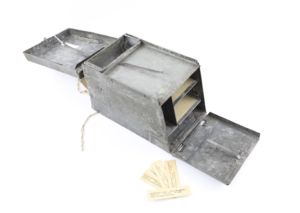
January 16, 2018
Did you know that rural Hennepin County was served by one of the nation’s few female mail carriers for nearly four decades? Elizabeth Titus of Robbinsdale carried this box with her for the duration of her 38-year career in Hennepin County. On rural routes, customers depended on their carriers to do much more than only deliver the mail; specialized boxes like this one were designed to serve as a miniature, portable post office, with slots for stamps and supplies, and room to hold cash collected from customers.
Elizabeth started her career as a mail carrier during World War I, a time when the post office was forced by labor force shortages to consider women for more positions. She started out as a substitute, often delivering wartime news – both reassuring and sometimes heartbreaking – from loved ones far away from home. Eventually she got her own permanent routes, covering an approximate 1,000 miles each month.
Working as a rural mail carrier was a job filled with both joys and challenges. A farm resident herself, Elizabeth was familiar with the rigors of rural life. In addition to delivering the mail, she at times helped put out fires or capture errant cattle!
The note on this stamp box, written by Elizabeth herself, says it was put into service in 1918. At that time, Elizabeth delivered the mail using a team of horses. Eventually she switched to a truck, although for many years horses remained the most effective way to navigate the mud and snowdrifts sometimes found on Hennepin County’s more rural roads.
The stamps in this box are marked Route 11. During the 1940s and early 1950s Elizabeth was delivering mail to approximately 460 families – and increasingly, businesses — along rural Route 11. The stamps shown here are for the Reinhard Brothers, 4301 Highway 7 in St. Louis Park.
The worst part of her job? According to Elizabeth, it was poison ivy.
“You can shovel away snow,” she told the Minneapolis Morning Tribune in 1946, “you can work from 6 a.m. until 2 a.m. the next day during Christmas, you can get through in spite of mud, loads of chicks, turtles, and catalogues but very seldom can you escape that ole debbil poison ivy.”
She retired in 1953, splitting her time between her home in Robbinsdale and her new husband’s home in Michigan.
